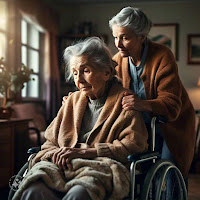The Physical Sufferings of Bed-Ridden Patients: An In-Depth Exploration
Bed-ridden patients endure a multitude of physical sufferings that significantly impact their quality of life. Long term immobility leads to a host of health issues, from bedsores to muscle atrophy, creating a challenging and painful existence. Understanding the physical sufferings of bed-ridden patients is crucial for developing compassionate care strategies and improving their overall well-being. This blog post delves into the various physical ailments that bed-ridden patients face and highlights the importance of comprehensive care.
Bedsores: A Painful Reality for Bed-Ridden Patients
One of the most prevalent physical problems for bed-ridden patients is the development of bedsores, also known as pressure ulcers. Bedsores develop when continuous pressure on the skin inhibits blood flow, causing tissue damage. Bedridden patients are more prone to bedsores on bony areas including the heels, hips, and lower back. These sores can range from modest redness to serious, open lesions that are easy to infect.
Bedsores create continual agony and anguish, which has a substantial impact on bed-ridden patients' quality of life. Bedsores must be prevented with rigorous care, which includes regular repositioning, the use of specialist mattresses, and good hygiene. There are mattress available for bedsores. Bedsore mattresses, also known as anti-bedsore mattresses or pressure ulcer mattresses, are specialist medical mattresses that can help prevent or treat bedsores. Despite these efforts, bedsores remain a persistent issue for bed-ridden patients and their caretakers.
https://www.amazon.in/Carent-Anti-Decubitus-Anti-Bedsore-Alternating-Range-QDC303/dp/B0BF521RBB/?tag=mypurchase202-21
Muscle Atrophy: The Loss of Strength in Bed-Ridden Patients
Muscle atrophy refers to the loss or thinning of muscle tissue. Muscle atrophy makes the muscles appear smaller than normal. Muscle atrophy can be caused by hunger, age, heredity, a lack of physical activity, or specific medical disorders. Muscle atrophy is another major physical ailment suffered by bedridden people. Prolonged immobility weakens and shrinks muscles, making it difficult for patients to regain their strength and movement. Muscle atrophy affects not just the legs and arms, but also the core muscles, which are required for proper posture and stability.
Muscle atrophy in bed-ridden individuals creates a vicious circle of dependency and immobility. As their muscles decrease bed-ridden patients become more reliant on caregivers for even the most basic functions, such as sitting up or moving in bed. Physical therapy and passive exercises are critical in preventing muscle atrophy, but the process is lengthy and takes persistent effort from both bedridden patients and caregivers.
Respiratory Complications in Bed-Ridden Patients
Because of their incapacity to move and change positions often, bedridden individuals are more likely to develop respiratory difficulties. A lack of exercise can cause fluid accumulation in the lungs, raising the risk of pneumonia and other respiratory diseases. Bed-ridden patients may also have shallow breathing, which lowers oxygen intake and might lead to additional health problems.
Regular repositioning, promoting deep breathing exercises, and ensuring sufficient hydration are all important ways to prevent respiratory issues in bed-ridden patients. Caregivers play an important role in monitoring the respiratory health of bed-ridden patients and responding quickly if any problems emerge
Circulatory Issues: Blood Clots in Bed-Ridden Patients
Circulatory issues are a major worry for bedridden people. Prolonged immobility can impair blood circulation and increase the risk of deep vein thrombosis (DVT). DVT occurs when blood clots form in deep veins, typically in the legs, and can be fatal if the clot moves to the lungs and produces a pulmonary embolism.
Bed-ridden patients require constant movement to prevent blood clots, even if it is as simple as passive range-of-motion exercises performed by a caregiver. Compression stockings and blood thinners may also be used to enhance circulation and lower the risk of clots. Vigilance is required, as early detection and treatment of DVT can save the lives of bedridden
Gastrointestinal Challenges Faced patients.by Bed-Ridden Patients
Bed-ridden patients frequently experience gastrointestinal difficulties as a result of their sedentary lifestyle and often changing nutrition. Constipation is a common condition caused by inadequate physical activity and insufficient fluid intake. Bedridden patients may also lose their appetite, resulting in poor nutrition and worsening their general health. Bed-ridden individuals are prone to urinary tract infections also. Regular change of catheter is important if the patient has one fixed.
It is critical to provide bed-ridden patients with a balanced, fibre-rich diet as well as appropriate fluids while addressing gastrointestinal disorders. In some circumstances, medicines or stool softeners may be required to relieve constipation and maintain gastrointestinal health in bed-ridden individuals.
Skin wellness and hygiene for bedridden patients
Maintaining skin integrity and hygiene is an ongoing challenge for bed-ridden individuals. Prolonged contact with bedding and inability to move independently can cause skin irritation, fungal infections, and other dermatological problems. Bed-ridden patients are also at risk of developing moisture-associated skin damage (MASD), which is caused by prolonged contact with perspiration, urine, or faeces.
Skin problems can be avoided by cleaning on a regular basis, using barrier lotions, and keeping bed-ridden patients dry and comfortable. Caregivers must be alert to any changes in skin health and take fast action to prevent minor irritations from turning into serious problems.
Pain Management for Bed-Ridden Patient
Chronic pain is a common problem among bed-ridden patients, resulting from a variety of causes such as bedsores, muscular atrophy, and joint stiffness. Managing this pain is critical to improve the quality of life for bedridden persons. Medication, physical therapy, and alternative therapies like massage or acupuncture are all possible pain management techniques.
Effective communication between bed-ridden patients and their caregivers is critical in managing discomfort. Bed-ridden patients should feel free to discuss their pain levels and needs, allowing caregivers to adjust pain management measures to their individual needs.
Technological Advancements in the Care of Bed-Ridden Patients
Medical technology advancements have substantially improved the care of bedridden patients. Bedsores can be avoided by using specialized mattresses and beds with pressure-reduction features. Mobility aids and assistive technologies allow bedridden individuals to execute previously difficult exercises and motions.
Telemedicine has also proven to be an invaluable tool, allowing bedridden patients to obtain medical consultations and monitoring without having to attend the hospital. These technological advancements improve caregivers' ability to handle the physical sufferings of bed-ridden patients efficiently.
Conclusion
Bed-ridden people suffer from a wide range of physical ailments, including bedsores, muscle atrophy, respiratory troubles, circulatory problems, gastrointestinal issues, and chronic pain, constipation, anal stenosis. Understanding these obstacles is essential for delivering comprehensive and compassionate care to bedridden patients. By addressing their physical requirements and assisting their caretakers, we can improve the quality of life for bed-ridden patients and help them navigate their tough circumstances with dignity and comfort. We can make a significant difference in the lives of bed-ridden patients by continuing our education, advancing technology, and remaining compassionate.




Comments
Post a Comment